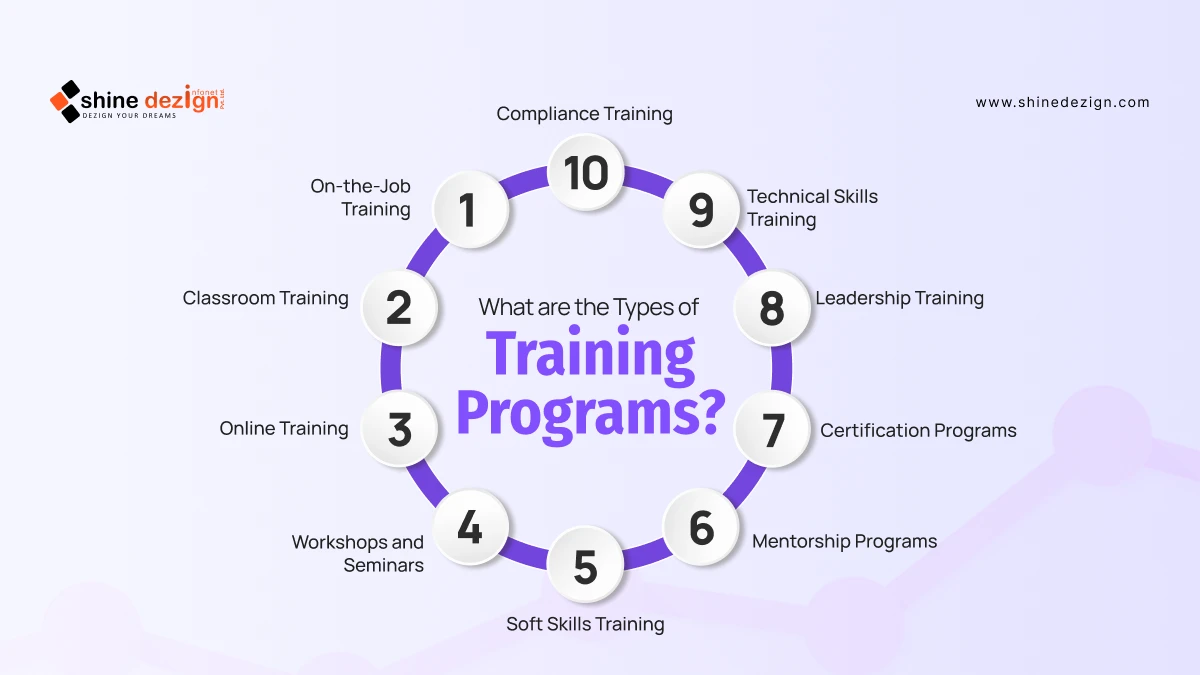Ongoing learning and skill acquisition are critical to success. Training programs are formalized avenues for people to gain new knowledge & learn new skills, allowing them to align with changing industry requirements. Through workshops, online training, or hands-on training, the programs impart participants with the tools required to perform well in their positions.
This tutorial will explore what training programs are, their benefits & how to make the proper choice, focusing on preparing a culture of development and advancement for the workplace.
What is a Training Program?
A training program is a systematic plan that seeks to improve the skills, knowledge & capabilities of persons in a specific career or vocation. Training programs can be aimed at various groups of persons like employees, students, or professionals looking to advance their expertise.
Training programs can be presented in different forms like workshops, seminars, online training & practice training. The primary intention is to equip participants with the tools & information they require to perform their jobs effectively and efficiently.
What are the Benefits of Training Programs?
Training programs have numerous benefits for individuals and organizations. Some of the primary benefits are mentioned hereunder:
Skill Development: Training programs allow people to learn new skills or reinforce existing ones, making them more efficient at work.
Increased Productivity: Trained employees are more productive as they can deal with their duties & problems more effectively.
Employee Satisfaction and Retention: Training organizations demonstrate that they are concerned about the development of their employees, so job satisfaction rises & turnover falls.
Flexibility to Change: Training programs in a rapidly changing work environment allow employees to adopt new technologies, methods & industry trends.
Better Performance: Training can lead to improved performance as employees apply their new skills on the job.
Career Advancement: For employees, training programs can open new career opportunities & avenues for advancement.
What are the Types of Training Programs?
Training programs are of many types, each with a distinct purpose & target audience. These are ten typical types:

1. On-the-Job Training
On-the-job training (OJT) is a hands-on method whereby employees learn through performing their job function with the support of more experienced colleagues or supervisors.
This type of training allows for the deployment of skills at the moment in a real environment. Hence, it is pretty effective. On-the-job training is particularly important when it comes to using fresh talent entering the company since it familiarizes them with the work environment & procedure as well as giving hands-on exposure.
It also encourages a sharing culture whereby knowledge is shared, which enhances team cohesion.
2. Classroom Training
Classroom training refers to the application of traditional face-to-face instruction, where a trainer or teacher can be present. It is best suited to convey theoretical information & group discussion. Classroom training may include lectures, interactive sessions & testing to ascertain understanding.
It ensures immediate interaction among participants and instructors, making it possible to provide instantaneous feedback & explanation of knowledge. It is generally utilized in training fundamental knowledge across all industries, such as business, healthcare & education.
3. Online Training
Online training programs are gaining popularity due to their flexibility & accessibility. Trainees are able to learn at their own will, accessing material & resources through an internet connection from anywhere. Online training can include video lectures, quizzes & interactive modules to suit different learning styles.
This mode is particularly useful for working individuals or individuals based in remote locations since it eliminates the travel component & allows standalone learning. Most companies also use online training to provide training to a larger population.
4. Workshops and Seminars
Workshops and seminars are typically short-term trainings in specific areas or skills.
Workshops involve hands-on activity, group work & practice, where those attending can apply what they learn in real time. Seminars are lecture-based but with some audience participation.
Such formats are ideal for developing skills, networking, and knowledge exchange among professionals of the same type. They provide an opportunity for attendees to network with gurus & peers, resulting in collaboration and innovation.
5. Mentorship Programs
Mentorship programs pair novice individuals with seasoned professionals who provide guidance, advice & knowledge transfer.
This training develops professional and personal growth by allowing mentees to learn from the experience of the mentors. Mentorship can take the form of individual sessions, group meetings, or informal chats.
The bond established by mentorship can result in elevated confidence, enhanced decision-making capacity & broadened professional connections. Mentorship programs are commonly used by organizations to develop leaders and foster talent.
6. Certification Programs
Certification programs are meant to give people credentials in a particular field of expertise, which is usually needed to further one’s career.
They typically include a formal syllabus, exams, and practical applications to equip members to industry standards. Being certified can increase an individual’s credibility & marketability within their field, demonstrating they take professional development seriously.
A majority of the fields, such as IT, healthcare & finance, have designed certification programs to certify knowledge and skills, so they are mandatory for career progression.
7. Leadership Training
Leadership training focuses on developing the competencies & skills necessary to lead and manage effectively.
The training courses typically cover topics such as communication, decision-making, conflict resolution & team dynamics. Leadership training may be offered in the form of workshops, coaching, or full-course training and is essential for those wishing to move into managerial roles.
By equipping prospective leaders with the skills they will use to engage & inspire their teams, organizations are able to create a culture of excellent leadership and realize complete success.
8. Compliance Training
Compliance training helps ensure that employees are aware of and adhere to legal & regulatory standards governing their business.
Such training is necessary to maintain ethical practice & avoid legal issues. Compliance training may comprise such topics as workplace safety, data protection, anti-harassment policy & industry-specific regulations.
Compliance training is typically embraced by organizations to make their employees aware of new legislation and legislation, thus establishing a culture of responsibility & accountability.
9. Technical Skills Training
Technical skills training is directed at technical job or industry-specific skills, such as programming, data analysis, or equipment operation.
Technical skills training is required for technical employees, as it renders them competent in utilizing the tools and technology they require to perform their work.
Technical skills training can be provided through hands-on workshops, online courses, or certification training. By investing in technical skills training, organizations can enhance their employees’ competence & stay ahead in a rapidly changing market.
10. Soft Skills Training
Soft skills training is centered on developing interpersonal skills, such as communication, teamwork, problem-solving & emotional intelligence.
These skills are essential in effective collaboration and building relationships in the work environment. Soft skills training can be achieved through workshops, role-playing & group discussions, which allow participants to rehearse & master their skills.
Organizations realize the importance of soft skills in developing a healthy working culture & enhancing general team performance, making this type of training more valuable.
How to Select a Training Program?
Selecting a good training program is based mostly on getting the right one. The following are some steps to take when choosing a training program:
Identify Your Goals: Define what you want to get out of the training. Having clear objectives will allow you to identify a program that addresses your requirements.
Evaluate Your Learning Style: Consider the way you learn best—practical, visual, or verbal. Choose a course that suits your preferred learning style.
Study Choices: Study various training courses within your vicinity or online. Look for reputable providers who enjoy good reviews & recommendations.
Verify Credentials: Ensure that the trainers or instructors are trained & experienced in the subject matter they are presenting.
Think About the Format: Decide if you prefer face-to-face training, online training, or a blend. Each has advantages & disadvantages.
Evaluate Costs: Review your budget and the cost of the training program. Find programs that represent good value for money.
Ask for Recommendations: Question your co-workers, mentors, or members of your professional association about suggestions for good training programs they have experienced.
Review Results: Seek out programs that offer quantifiable results or testimonials of previous participants.
Conclusion
Training programs play a key role in building individuals and their careers. These bring several benefits, from the development of skills to productivity improvement & professional growth.
With an understanding of the different types of training programs available & following a systematic approach to selecting one, organizations & individuals can make effective training possible. Training is not just about building skills; it is also about building a learning & growth culture.
Your questions, our answers
The primary goal of a training program is enhancing the skills, knowledge & abilities of individuals to maximize their performance in specific jobs or tasks.
Training programs can benefit organizations by improving the productivity of staff members, improving job satisfaction, reducing rates of turnover & sustaining responsiveness to changes in the industry.
On-the-job training, classroom training, web-based training, workshops, mentorship programs, certification programs, leadership development training, compliance training, technical skills training & soft skills training are some of the most common examples.
In choosing an appropriate training program, identify your goals, assess your learning style & investigate options, check credentials, review the format, compare prices, seek recommendations & review outcomes.
Yes, online training courses can be very effective, being flexible & accessible. Its effectiveness tends to rely on the depth of content & the interest of the trainees.
Recent Posts
- Top 10 Cities in India for Internship Opportunities
- Campus to Career Journey: The Role of Internships in Getting into Big Tech
- High Income Skills to Learn in 2026
- Web Developer Salary in India 2025: How Much Does a Developer Earn?
- Digital Marketing Salary Guide: Entry-Level to Expert Roles, Skills & Requirements













